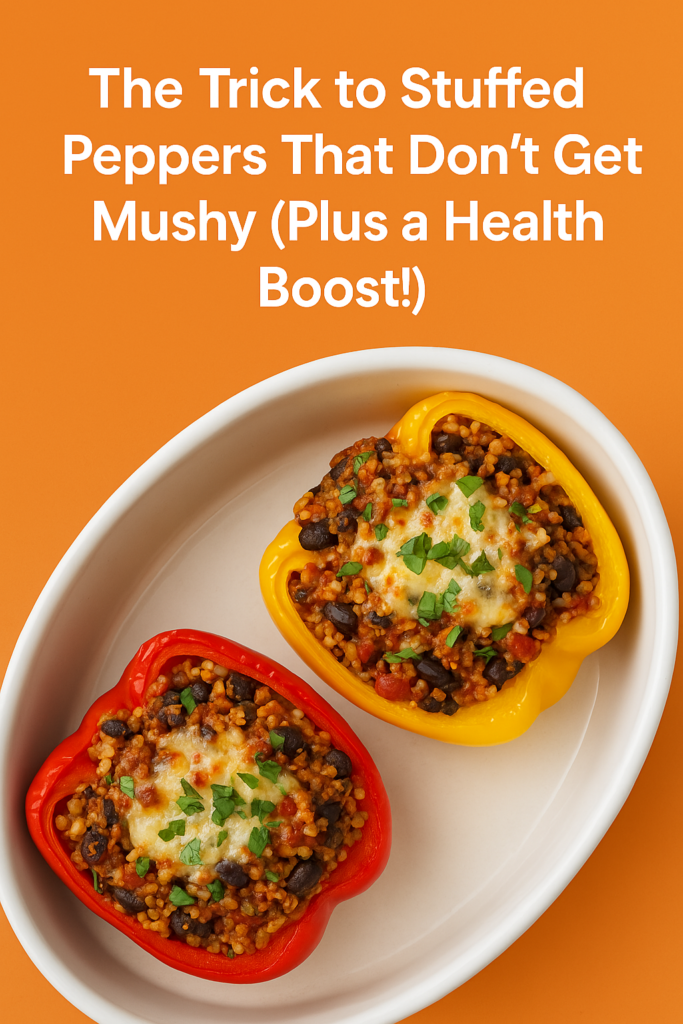
If you’ve ever tried to make stuffed bell peppers, only to end up with a soggy, limp mess that barely holds its shape, you’re not alone.
While this classic comfort dish is beloved for its flavor and versatility, getting the texture right can be surprisingly tricky.
But don’t worry—today, we’re uncovering the secret to perfectly tender-yet-firm stuffed bell peppers that hold their structure, deliver bold flavor, and even offer a nutritional upgrade.
Yes, you can have your stuffed peppers and eat them, too—without the mush!
Let’s dive into the ultimate guide for mastering stuffed bell peppers, with a health-boosting twist that makes this dish as nourishing as it is delicious.
Why Do Stuffed Bell Peppers Get Mushy?
Let’s be real—no one wants to dig into a soggy, watery stuffed pepper.
You know the kind: it collapses the moment your fork hits it, the filling spills everywhere, and the whole dish feels more like a casserole than a structured meal.
If you’ve ever wondered what went wrong, here’s a breakdown of the most common reasons stuffed bell peppers lose their texture and end up mushy:
Overcooking the Peppers
The biggest culprit is often time.
Bell peppers are naturally full of water—over 90% of their content is water—so cooking them too long causes that moisture to break down the cell walls.
The result?
Limp, lifeless peppers that don’t stand a chance at holding shape.
Many recipes recommend baking stuffed bell peppers for 45 minutes to an hour.
That might work if you’re baking them with raw rice or meat, but in most modern recipes where you’re using pre-cooked fillings, that’s just too long.
Using Wet or Unbalanced Fillings
Stuffed bell peppers are only as good as what you put inside them.
A filling that’s too wet—think tomato-heavy sauces, overcooked rice, or sautéed veggies with leftover water—can release even more liquid into the pepper as it bakes, turning everything into a soggy mess.
Another common mistake?
Skipping the seasoning in the filling.
Even if the peppers stay firm, a bland interior can ruin the overall experience.
Parboiling the Peppers
Once upon a time, boiling peppers before stuffing them was standard practice.
The idea was to soften them for easier stuffing and ensure they were cooked through in the oven.
But here’s the problem: boiling forces water into the pepper walls, which leads to a softer texture—and not in a good way.
Even a quick dunk can overdo it.
And if you fill already-saturated peppers with a moist filling? Mush city.
Using Thin-Skinned Peppers
Another sneaky cause of mushiness?
Choosing overripe or thin-skinned peppers.
These break down faster in the oven, especially red or yellow ones that are more mature than green peppers.
While colorful peppers are delicious and sweeter, they also soften quicker—something to keep in mind when timing your bake.
The Trick to Firm, Flavorful Stuffed Bell Peppers
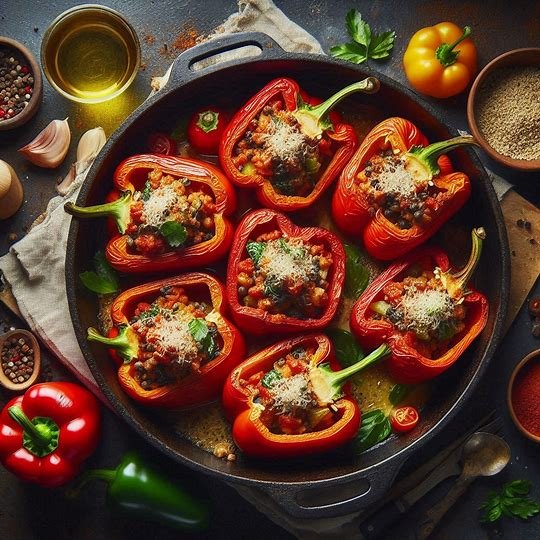
Now for the good news: avoiding mushy stuffed bell peppers is not only possible—it’s easy once you know the secret.
The trick is so simple, you’ll wonder why you didn’t think of it sooner.
The Game-Changer: Pre-Baking the Peppers (Empty!)
The most effective method for achieving a firm yet tender pepper is to roast the bell peppers—empty—for 10 minutes at 400°F (200°C) before adding any filling.
Here’s why it works:
- It jumpstarts the cooking process without overdoing it.
- It allows some of the internal moisture to evaporate early.
- It helps caramelize the edges, adding rich flavor.
- It slightly softens the walls, making stuffing easier without sacrificing structure.
This step ensures that once your filling goes in, the peppers won’t break down from a double dose of moisture and heat.
They’ll be just soft enough to cut with a fork, but sturdy enough to stand tall and proud on the plate.
Say Goodbye to Boiling
Put the pot of water away—you don’t need it.
Not only does boiling peppers zap them of flavor, but it also makes it nearly impossible to control their final texture.
Roasting, on the other hand, gives you control and concentrates the natural sweetness of the peppers instead of watering them down.
Roast Cut-Side Up
When placing your empty peppers in the oven, always do so cut-side up.
This positioning:
- Prevents steaming from the inside.
- Helps the top edges slightly blister for flavor.
- Keeps liquid from pooling inside during the roast.
If you’re working with thinner-skinned peppers (like reds or oranges), you can reduce the pre-roast time to 8 minutes to prevent over-softening.
Bonus Tip: Use a Casserole Dish with a Tight Fit
Peppers bake best when they’re upright and close together.
Choose a dish that keeps them snug.
Not only does this prevent tipping, but it helps them cook more evenly and traps just enough steam to keep things moist—but not wet.
The Perfect Stuffed Bell Peppers Recipe (With a Healthy Twist)
Now that you know why stuffed bell peppers get mushy and how to avoid it, let’s get into the fun part—making the perfect version at home.
This recipe isn’t just your average comfort food—it’s a wholesome, nutritious twist on the classic dish that’s easy to make, endlessly customizable, and packed with flavor.
This recipe is ideal for weeknight dinners, meal prepping, or even entertaining.
With fiber-rich grains, plant-based protein, and vitamin-loaded veggies, it checks all the boxes for a satisfying, balanced meal.
⭐ What Makes This Recipe Special?
- No mushy peppers! Thanks to our pre-bake trick, the texture is spot on.
- Naturally gluten-free (if using quinoa or gluten-free grains).
- Easy to adapt for vegetarian, vegan, or high-protein diets.
- Kid-friendly, meal-prep-friendly, and freezer-friendly.
Let’s cook!
🛒 Ingredients You’ll Need
For 4 large stuffed bell peppers, here’s what you need:
Peppers:
- 4 large bell peppers, any color (red, yellow, orange, or green)
- 1 tablespoon olive oil (for sautéing and brushing peppers)
Filling:
- 1 small yellow onion, finely chopped
- 2 cloves garlic, minced
- 1 cup cooked quinoa or brown rice (quinoa for more protein!)
- 1 cup black beans, rinsed and drained (or use cooked lentils)
- 1 cup diced tomatoes, drained (fire-roasted for extra flavor)
- 1/2 cup corn kernels (optional, fresh or frozen)
- 1 teaspoon smoked paprika
- 1/2 teaspoon ground cumin
- Salt and freshly ground black pepper to taste
Topping:
- 1/2 cup shredded cheese (optional – mozzarella, cheddar, or dairy-free alternative)
- Chopped fresh herbs like parsley or cilantro, for garnish
👩🍳 Step-by-Step Instructions
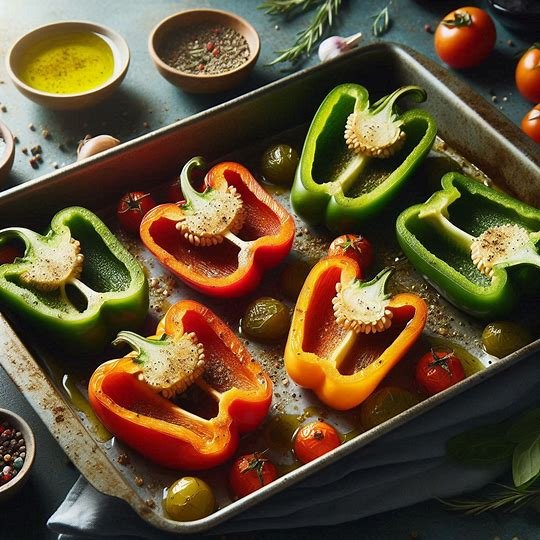
1. Preheat and Prep
Preheat your oven to 400°F (200°C). Cut the tops off your bell peppers and scoop out the seeds and membranes. Lightly brush the insides with olive oil.
Place the empty peppers cut-side up in a baking dish. Roast them in the oven (unfilled) for 10 minutes to soften slightly and build flavor.
2. Make the Filling
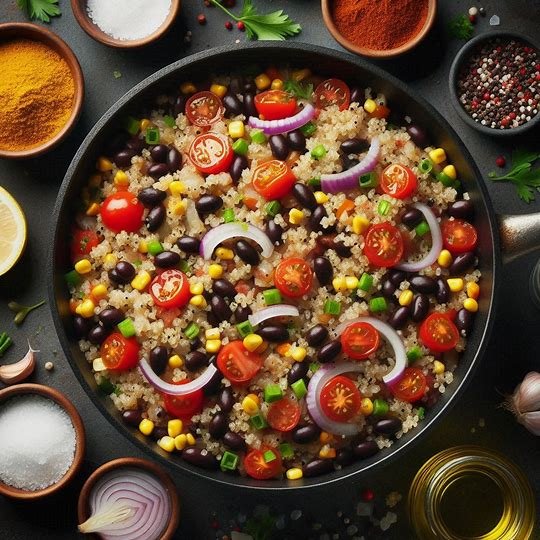
While the peppers are roasting, heat olive oil in a skillet over medium heat.
Add chopped onion and sauté for 2–3 minutes until translucent.
Add garlic and stir until fragrant, about 30 seconds.
Next, stir in your quinoa (or brown rice), black beans, diced tomatoes, corn (if using), and spices.
Sauté the mixture for 4–5 minutes, letting it absorb flavor and heat through.
Season to taste with salt and pepper.
3. Stuff the Peppers
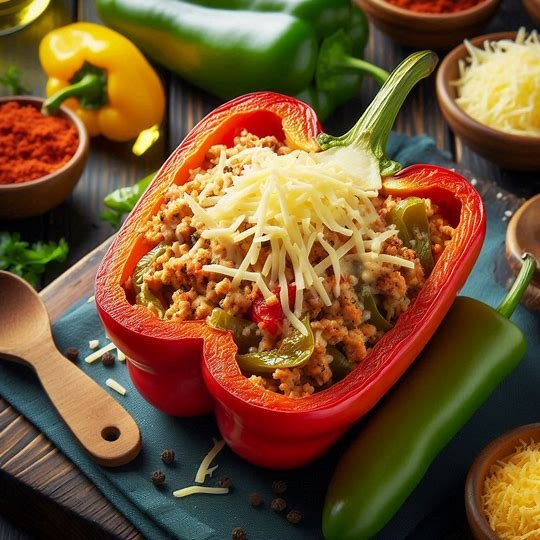
Carefully remove the pre-roasted peppers from the oven.
Use a spoon to fill each one with the mixture, pressing down gently to pack the filling.
Top with shredded cheese if using.
4. Bake to Perfection
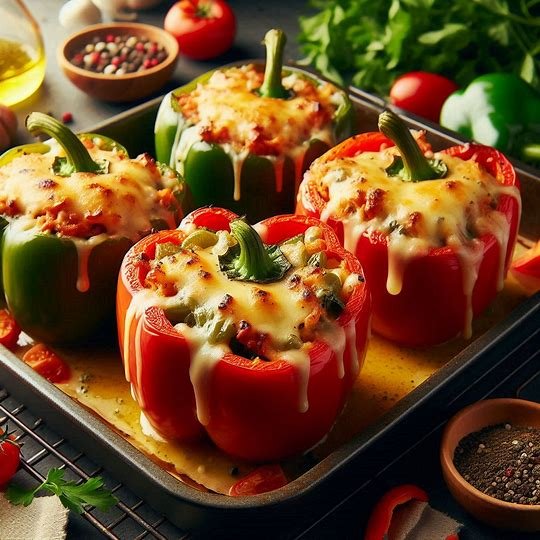
Return the stuffed peppers to the oven and bake for 15–20 minutes, or until the cheese is melted and bubbly and the filling is hot all the way through.
5. Garnish and Serve
Top with freshly chopped herbs and serve hot.
These stuffed bell peppers pair well with a side salad, avocado slices, or a dollop of Greek yogurt or dairy-free sour cream.
🔁 Recipe Variations
- Vegan: Skip the cheese or use a vegan cheese.
- Meat Option: Add cooked ground turkey, beef, or shredded chicken to the filling.
- Low Carb: Replace grains with cauliflower rice.
- Spicy: Add diced jalapeños or hot sauce to the filling.
Health Benefits of Stuffed Bell Peppers
Beyond their crave-worthy taste, stuffed bell peppers are a powerhouse meal when it comes to nutrition.
Whether you’re looking to boost energy, eat more veggies, or support your gut health, this dish has you covered.
Let’s break down the major health benefits packed into every bite.
🌈 1. Bell Peppers: Vitamin-Packed Antioxidant Powerhouses
Bell peppers—especially red and yellow varieties—are among the most nutrient-dense vegetables you can eat. They are:
- Loaded with vitamin C: One medium red bell pepper has more than 150% of your daily recommended intake.
- Rich in antioxidants: Including beta-carotene, lutein, and zeaxanthin, which support eye health and protect cells from oxidative damage.
- Low in calories: Just 30–50 calories per pepper, making them ideal for volume-based, satisfying meals.
Bonus: The vibrant colors aren’t just pretty—they’re indicators of powerful phytonutrients.
💪 2. Whole Grains = Energy + Digestive Health
Using quinoa or brown rice in your stuffed bell peppers adds long-lasting, complex carbohydrates that:
- Fuel your body and brain.
- Help stabilize blood sugar levels.
- Deliver fiber, which supports digestion and helps you feel fuller longer.
Quinoa also brings a unique benefit: it’s a complete protein, meaning it contains all nine essential amino acids—a great win for plant-based eaters.
🧠 3. Beans = Plant-Based Protein and Brain Food
Black beans or lentils add creamy texture, protein, and fiber to your stuffed bell peppers. They’re also full of:
- Folate (supports brain function and red blood cell production)
- Iron (supports energy and oxygen transport)
- Magnesium (calms the nervous system and supports muscle recovery)
💚 4. Olive Oil = Heart-Healthy Fat
Just a tablespoon of olive oil enhances nutrient absorption (especially for fat-soluble vitamins like A, D, E, and K) and supports cardiovascular health thanks to its monounsaturated fat content and antioxidants like polyphenols.
👩⚕️ 5. Balanced Meal, Naturally
When you assemble a plate of these stuffed bell peppers, you’re enjoying:
- Lean protein
- Healthy fats
- Complex carbs
- Fiber
- Antioxidants
That’s what we call a complete, whole-food meal that not only tastes amazing but supports your body from the inside out.
Tips for Customizing Your Stuffed Bell Peppers
The beauty of stuffed bell peppers is that they’re not a one-size-fits-all dish.
Once you’ve mastered the base technique (hello, perfectly firm peppers!), the possibilities for flavor combinations, dietary preferences, and nutritional upgrades are endless.
This chapter is all about helping you personalize your stuffed bell peppers to match your cravings, pantry, or lifestyle.
🧀 Cheesy or Dairy-Free
Some people love gooey melted cheese on their stuffed bell peppers—others prefer to skip dairy altogether.
- For cheese lovers: Use mozzarella, cheddar, pepper jack, or feta to enhance the filling or melt on top.
- For dairy-free or vegan: Opt for plant-based cheeses made from cashews or coconut oil, or skip the cheese and add flavor with nutritional yeast, herbs, or a drizzle of tahini after baking.
🍖 Add Animal Protein
If you want to increase the protein content or add heartiness to your stuffed bell peppers, meat is an easy add-in.
- Try ground turkey, chicken, or lean beef—seasoned and browned before mixing into the filling.
- Shredded rotisserie chicken is great for a quick hack.
- For a Mediterranean twist, try crumbled Italian sausage or ground lamb with oregano and lemon zest.
🥦 Go Plant-Forward
Already vegetarian or looking to eat more plants?
You’ve got options.
- Add chopped spinach, kale, or zucchini to boost fiber and nutrients.
- Mix in mushrooms, which add umami and a meaty texture.
- Use chickpeas, lentils, or tempeh for plant-based protein power.
Pro tip: Don’t overcrowd the filling with watery vegetables—lightly sauté or blot them first to avoid sogginess.
🌾 Switch Up the Grains (or Skip Them!)
Quinoa and brown rice are the go-to grains for most stuffed bell pepper recipes, but don’t stop there:
- Barley and farro add chewiness and a nutty flavor.
- Couscous or bulgur wheat make for lighter, fluffy fillings.
- Cauliflower rice or chopped mushrooms create a low-carb, grain-free version.
Trying to reduce carbs? Go fully grain-free and bulk up the filling with extra beans and veggies.
🌶️ Make It Spicy or Global
Once you nail the basic method, try taking your stuffed bell peppers around the world:
- Mexican-style: Add taco seasoning, corn, black beans, and top with avocado or salsa.
- Italian-style: Use marinara, basil, oregano, and mozzarella.
- Greek-style: Add olives, feta, sun-dried tomatoes, and oregano.
- Middle Eastern-style: Mix in chickpeas, mint, cumin, and a tahini drizzle.
Want heat? Add cayenne, jalapeños, harissa, or your favorite hot sauce.
🧂 Add Crunch or Texture
To keep every bite interesting:
- Sprinkle toasted nuts (pine nuts, almonds) on top after baking.
- Drizzle with pesto, tzatziki, or a garlicky yogurt sauce for contrast.
- Garnish with chopped fresh herbs or green onions for a burst of freshness.
Customizing your stuffed bell peppers makes them more fun, flavorful, and suited to your needs—without sacrificing the simplicity of the original recipe.
So go ahead, experiment a little!
How to Store and Reheat Stuffed Bell Peppers
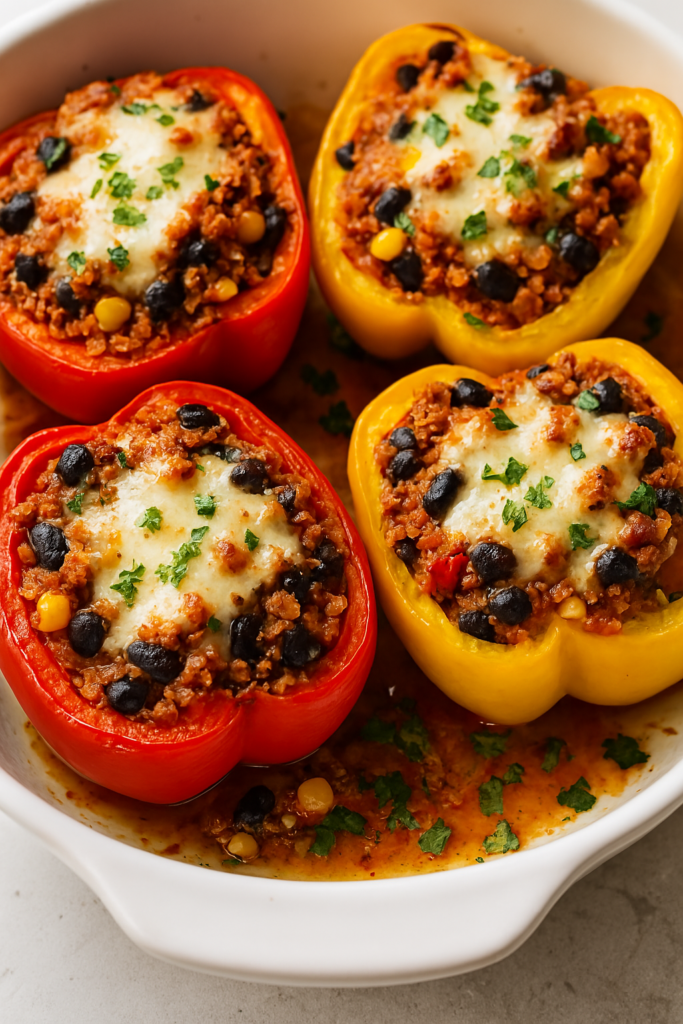
One of the reasons we love stuffed bell peppers so much?
They’re meal prep gold. Make a batch on Sunday, and you’ve got lunch or dinner ready to go for days.
Here’s how to properly store, freeze, and reheat your stuffed bell peppers so they stay as delicious as day one.
🧊 How to Store Stuffed Bell Peppers in the Fridge
If you’re planning to eat your stuffed peppers within a few days, refrigerate them properly:
- Allow the cooked stuffed bell peppers to cool slightly before storing.
- Transfer them to an airtight container or wrap them individually in foil or reusable wraps.
- Store in the refrigerator for up to 4 days.
👉 Tip: Place a paper towel in the container to absorb any moisture and preserve texture.
❄️ How to Freeze Stuffed Bell Peppers (Without Ruining Them)
Want to save some for later? Good idea—stuffed bell peppers freeze beautifully if done right.
Here’s how:
- Let the peppers cool completely after baking.
- Wrap each pepper individually in plastic wrap or foil.
- Place wrapped peppers in a freezer-safe zip-top bag or airtight container.
- Label with the date and contents.
They’ll keep in the freezer for up to 2 months.
👉 Tip: If you know you’re freezing them, slightly underbake during the second bake (after stuffing) to help them reheat better later.
🔥 How to Reheat Stuffed Bell Peppers (Without Drying Out)
Whether you’re pulling them from the fridge or freezer, reheating stuffed bell peppers is simple.
Reheating from the fridge:
- Oven: Bake at 350°F (175°C) for 15–20 minutes until heated through.
- Microwave: Place one pepper in a microwave-safe dish. Cover loosely and heat for 2–3 minutes, checking in 30-second intervals to avoid sogginess.
Reheating from frozen:
- Oven (preferred method): Bake at 375°F (190°C), covered with foil, for about 40–45 minutes. Remove the foil in the last 10 minutes to crisp the top.
- Microwave (for quick heat): Thaw overnight first, then reheat as above.
👉 Pro Tip: Add a tablespoon of broth or tomato sauce in the dish while reheating to prevent drying out and keep everything moist and flavorful.
With proper storage and reheating, your stuffed bell peppers can be just as enjoyable on day four as they were fresh out of the oven.
Whether you batch cook for the week or freeze for the future, this dish makes healthy eating easy, convenient, and oh-so-satisfying.
By now, you’ve unlocked the secret to making stuffed bell peppers that are tender, structured, and flavorful—not mushy and lifeless.
The simple tweak of pre-roasting your peppers before stuffing them is a total game-changer, and when combined with a well-balanced, nutrient-dense filling, it turns a classic comfort dish into something truly crave-worthy.
Let’s recap the essentials:
- Avoid boiling your peppers—it’s a fast track to soggy results.
- Pre-roast the empty peppers for 10 minutes at 400°F to enhance texture and flavor.
- Choose moisture-balanced fillings using whole grains, legumes, and cooked vegetables.
- Mix things up with custom ingredients that match your taste and dietary preferences.
- Store, freeze, and reheat like a pro so you can enjoy stuffed bell peppers all week long.
This isn’t just about fixing a common cooking mistake—it’s about elevating a meal that’s comforting, versatile, and healthy.
Whether you’re feeding your family, cooking for one, or prepping ahead, stuffed bell peppers are a delicious way to get more vegetables, fiber, and whole food goodness into your daily routine.
Ready to make this weeknight favorite your new go-to?
Try the method, test a few fillings, and discover your own signature twist on stuffed bell peppers.
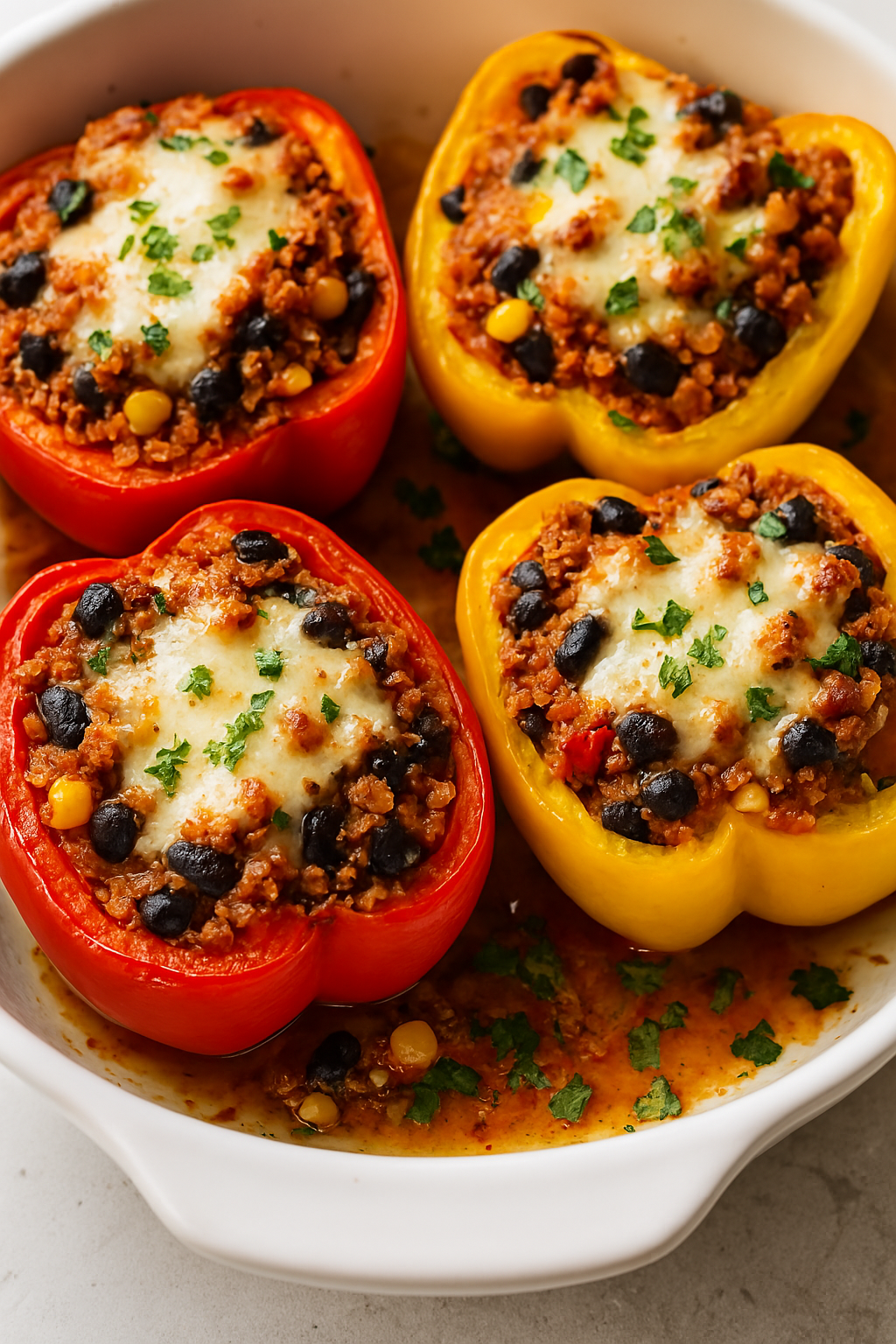
Healthy Stuffed Bell Peppers That Don’t Get Mushy
Ingredients
Equipment
Method
- Preheat oven to 400°F (200°C). Slice the tops off the bell peppers and remove the seeds and membranes. Lightly brush the inside of each pepper with olive oil.
- Place peppers cut-side up in a baking dish and roast empty for 10 minutes to soften slightly.
- Prepare filling: In a skillet, heat 1/2 tablespoon olive oil over medium heat. Sauté onion for 2–3 minutes until translucent. Add garlic and cook 30 seconds more.
- Stir in quinoa, black beans, tomatoes, corn, paprika, cumin, salt, and pepper. Cook for 4–5 minutes until warmed and well mixed.
- Remove peppers from the oven and fill each with the quinoa mixture, packing it in gently.
- Top with shredded cheese if using. Return to oven and bake for 15–20 minutes, until cheese is melted and filling is heated through.
- Garnish with herbs and serve hot.
- Calories: 290
- Protein: 12g
- Carbs: 38g
- Fat: 10g
- Fiber: 9g
- Sugar: 6g
- Sodium: 390mg
Notes
Don’t forget to bookmark this page or pin it for later—you’ll want to come back to it again and again!
📌 Save this recipe to Pinterest so you can find it fast on busy nights.
📷 Tried it? Snap a pic of your stuffed bell peppers and tag @CraveWorthyNutrition so we can share your creation with our community!
👉 Want more wholesome, satisfying meals?
Explore more healthy comfort food recipes on our blog—where real food meets real life.
❤️ You Might Also Like:
Now you know the trick—are you ready to level up your stuffed bell pepper game?
Let me know in the comments below which variation you’re excited to try, or share your best tip for keeping peppers firm and flavorful!
